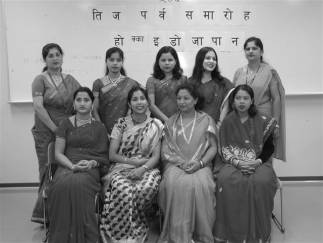|
Teej
Festival
"Teej"
or Haritalika is purely a women's festival. It
takes place in late August or early September.
The festival is a three-day long
celebration that combines sumptuous feasts as
well as rigid fasting. Through this
religious fasting, Nepali women pray for
marital bliss, well being of their
spouse and children and purification of their
own body and soul.

A
group picture taken during Teej Festival
Traditionally,
the ritual of Teej is obligatory for all
married women and girls who have reached
puberty. According to the holy books,
the Goddess Parbatee fasted and prayed
fervently for the great Lord Shiva to become
her spouse. Touched by her devotion, he made her
his wife. Goddess Parbatee, in gratitude, sent her
emissary to preach and disseminate this
religious fasting to women wishing prosperity
and longevity of their family’s the
lives. Thus, the festival of Teej was
born.
The
important part of the Teej is called the
"Dar-Khane-Din". On this day the
women, both married and unmarried,
assemble at one place, in their finest attires
(mostly women are seen wearing red garments
invariable and decked in all sorts of
jewellery), and start dancing and
singing with devotional Teej songs. The jollity
often goes on till midnight, after which the 24
- hour fasting commences. Some women stay
without any food or even a drop of
water while others take liquid and fruit. On
the third day, women goes to river and bath
with “datiwoon’ a plant with regular
nodules. Teej ends with Panchamee puja
(religious ceremony) with offerings of
flowers, fruits, etc., to Shiva and Parbati,
beseeching their blessing upon the
husband and family.
We,
Nepali women residing at Hokkaido Japan,
celebrated Teej of 2060 BS. The program was
organized on the auspicious day of Teej (on
Aug 29, 2003) at International Plaza of
Hokkaido University. All Nepali family
members, including women, men and
children, participated. The program was
started at 6:00 PM, by singing a Teej song
“Teej Ko Lahar Ayo Bari Lai”and later
the environment become livelier with group
dance. The additional funs of this
program were couple as well as group photo
sessions, jokes and musical chair competition. Finally,
we enjoyed with typical Nepali foods, as a part
of special dinner called DAR. The specialty of
this dinner was: individual women prepared
particular dish. Oh! Khir, Masu-Bahat
(meat and rice), Acchar, Tarkari (vegetable),
Salad, Noodles, etc., were so delicious that
we really enjoyed with these multiple tastes.
Finally, group dancing with famous Nepali
folk song “Wari Jamuna Pari Jamuna” ended
Teej festival around 9:00 PM.
Thanks
to all members of our HUNSA community who initiated
to organize Teej festival in foreign land,
this made us feel at home. Special thanks to
women group for their contributions in
preparation of food and performance of
Teej dance in typical Nepali dress
“Saree and Cholo”! After all, it has
become one of the memorable events of
our life: Teej Festival in Hokkaido, Japan!
Reported
by: Mrs. Gita Bhandari |
![]()